Dornier Do 217 N-1
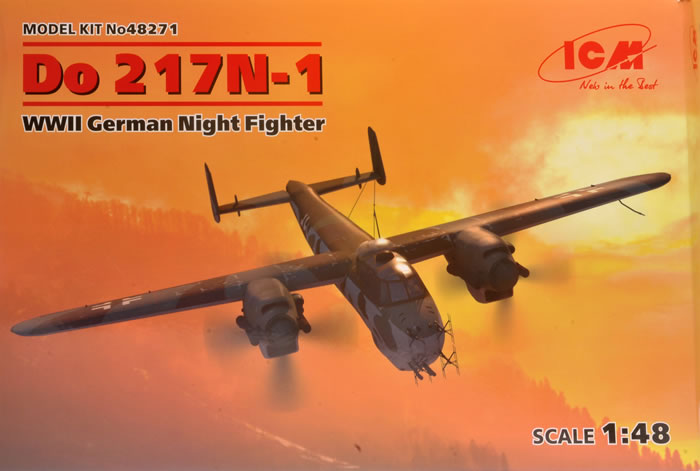
ICM, 1/48 scale
S
u m m a r y : |
Description and Item No.: |
ICM Kit No. 48271 - Dornier Do 217 N-1 |
Contents and Media: |
230 parts in medium grey plastic; seven parts in clear plastic; one decal sheet covering four subjects |
Price: |
£45.00 EU Price (£38.33 Export Price) plus shipping available online from Hannants |
Scale: |
1/48 |
Review Type: |
First Look |
Advantages: |
Crisp surface textures including finely recessed panel lines; high level of detail; separate control surfaces; high standard of moulding; engine and bomb bay detail included; engine nacelles and bomb bay may be built without interior parts. |
Disadvantages: |
Overscale radar antennae. |
Recommendation: |
It is great to see ICM working their way through important and interesting types in their 1/48 scale Dornier Do 17 and 217 families.
Surface textures, detail and moulding are all delivered to a very high standard, and the parts breakdown (in particular the ability to build the engine nacelles without the engines) should make this an easier build some of their earlier releases. |
Reviewed by Brett Green

G.W.H.s 1/144 Victor K.2 will be available online from Squadron.com
The Dornier Do 217 N-1 and N-2 were night fighter adaptations of the original Do 217 E heavy bomber design. The Do 217 N1 and N2 were the next stage of development following the disappointing Do 217 J night fighter.
The BMW 801 that powered the Do 217 J proved underpowered, so a night-fighter using the more powerful DB 603A-1 engine was designed. The first prototype flew on 31 July 1942. While it boasted much improved performance, it was still unpopular due to its poor agility and climb rate, and was prone to engine problems.
Ten pre-production series N variants were designated as test beds. Trials began in the summer of 1942. On 16 August the second prototype Do 217, N V2, entered trials,. The N V1 and N V2 were the main testbeds, and the DB 603 A-1s they were powered by were tested at high altitude. On 11 October 1942 the N V1 crashed after stalling with its landing gear down and crashing into Müritz Lake, killing the crew.
On 21 December 1942, 100-hour engine endurance trials began at Rechlin with the DB engines. The pistons became useless after 91 hours. Testing of DB 603 A-2 inline engines was carried out between 28 April and 8 May 1943, but the programme was beset by continual breakdowns and the project was abandoned. There was no further record of the N variant prototypes after 20 June 1943.
In April 1943, the third prototype, N-1/U was fitted with MG 151/20 and unspecified aerodynamic refinements. The machine was used in high-altitude de-icing tests, and the aircraft was tested with Lichtenstein BCR and Bernhardine radar.
In August ten of these aircraft were constructed, and between 27 and 31 August, they were fitted with their Schräge Musik at Erprobungsstelle Tarnewitz and Wismar Testing Facilities. The tenth N variant, designated N-0, underwent radio trials. The machine was tested with the Peil G VI/APZ 6, a later and more sophisticated variant automatic direction-finding equipment. On 2 December further tactical trials were carried out with infrared target-illuminating equipment. These trials were carried out with DB 601 powered J-1s.
After testing was completed, the two variants - the N-1 and N-2 - were fitted with FuG 202 radar. The N-1 variants had two sub-variants that were to follow the design of the E-2/E-4 and the J-1/J-2 with emphasis on range and endurance. Extra fuel tanks were added to the empty bomb bay.
For operations over water, the heavy night fighters were fitted with lifeboats and radio transmitters.
The bomb release gear remained even though it was no longer required, bringing the aircraft up to 15,000 kilograms (33,000 lb) on take-off, so it was barely able to reach 7,400 metres (24,300 ft). Fuel consumption lightened the load, and the Dornier could reach a maximum operational ceiling of 8,400 metres (27,600 ft). The speed of the N was a maximum of 500 kilometres per hour (270 kn) at 6,000 metres (20,000 ft).
The N-1 was essentially an alternative production of the J-1 version. Powered by a DB 603 it had similar armament to Do 217 J-2, retaining defensive armament.
The Do 217 N-1 entered service in April 1943. Some were modified with dorsal and ventral guns replaced by wooden fairings as Do 217 N-1/U1, conversion with Schräge Musik arrangement of four upward-firing 20 mm MG 151s as Do 217 N-1/U3. About 240 were built, but it was still overweight and performance was disappointing.
It was not until the more streamlined Do 217 N-2 entered service with 2,500 kg in weight reduction, improved armour protection for the crew, better performance and increased ceiling height, that it was finally a decent night fighter.*
* Historical text adapted from Wikipedia
Until now, there has never been a Dornier Do 217 night fighter offered straight-from-the-box in 1/48 scale. ICM has filled this gap in the market with their new 1/48 scale Dornier Do 217 N-1.
ICM's 1/48 scale Dornier Do 217 N-1 comprises 230 parts in grey plastic, seven parts in clear and a decal sheet with four marking options.
Quality of moulding is excellent. I could not find any imperfections on my sample. Surface detail is by way of very fine and crisply recessed panel lines. These are impressive. If there is any problem it is that they are so fine that a heavy coat of paint might obscure them.
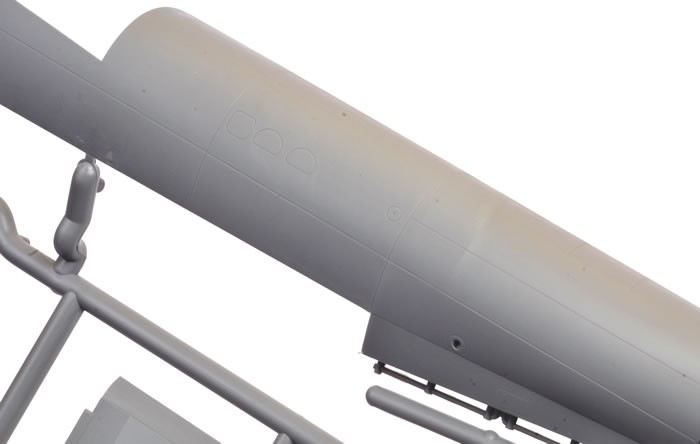
Sprue attachments are fairly narrow, but some do attach to highly visible areas such as the wing leading edges, so some care will be needed when cleaning up those parts.

The fuselage is broken down into two full-length halves including a long open lower-mid bomb bay. Four separate parts are supplied for the open bomb bay doors in addition to interior ceiling and detail parts. If the bomb bay is closed, a long single part is supplied to close the gap.
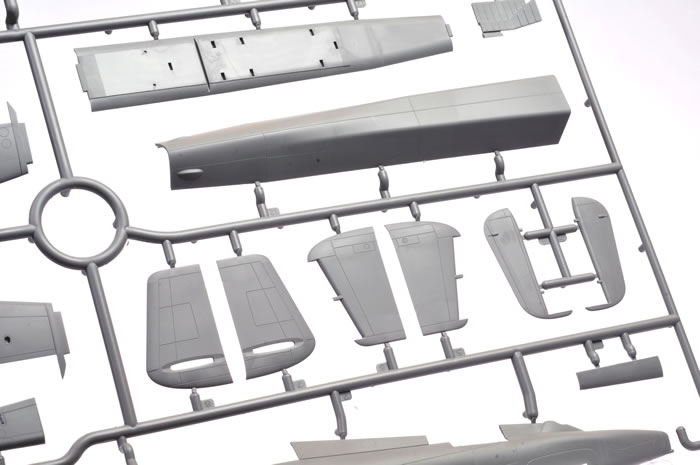
The fuselage wing root features a stout spar attached to the bomb bay forward bulkhead. This should ensure a solid fit for the wings.
Cockpit detail looks pretty good straight from the box although sidewall detail looks a bit shallow.

The plastic instrument panel features raised circles as instrument bezels and dial decals on the kit decal sheet. There are a few other decals for the cockpit too, including the compass.
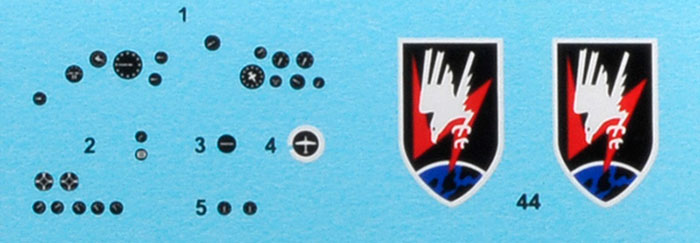
The FuG 202 Lichtenstein radar array is supplied in plastic. Although the antennae are reasonably thin, the limitations of injection moulded technology mean that they are still over scale. These should ideally be replaced with photo-etched parts.
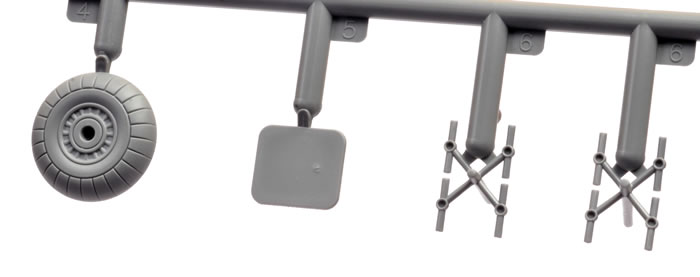
The wings are broken down simply as full span upper half with a saddle mount onto the mid fuselage, and separate parts for the port and starboard lower wing halves.

Elevators, rudders and ailerons are separate parts and may be posed to taste. The flaps are moulded shut.
The undercarriage looks stout. It is designed to be assembled and fitted to the lower wings after the engine nacelles are complete. You will easily be able to delay installing the legs until the model is otherwise built and painted.
The engine nacelles incorporate full main wheel bay detail. These are simply slotted into an opening in the bottom of the wing when the nacelles are complete.
Two full DB605A engines are included. These are nicely detailed and may be partially or fully displayed. The good news with this model is that if you do not want to display the engines, you may assemble the nacelles without them. This will considerably simplify the build for anyone not wanting to show the engines off.
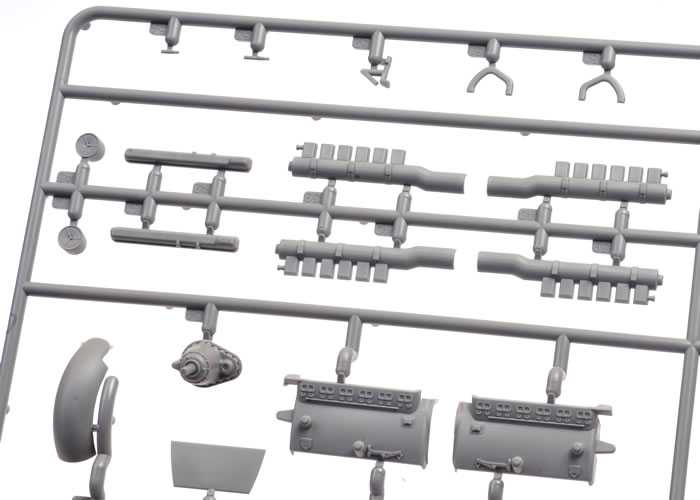
The clear parts are thin and free from distortion.
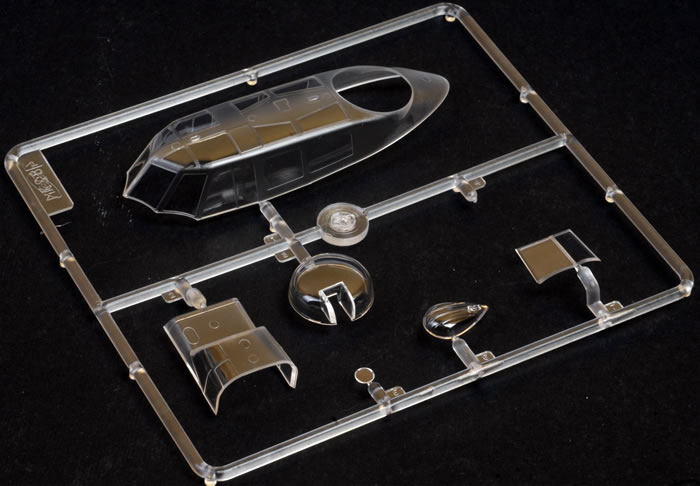
The sections of the canopy that are not meant to be clear are slightly frosted, which should avoid any confusion when masking.
Markings
Decals are well presented, in register and with good colour saturation. The decals are glossy and look much better than previous ICM decals that I have seen.
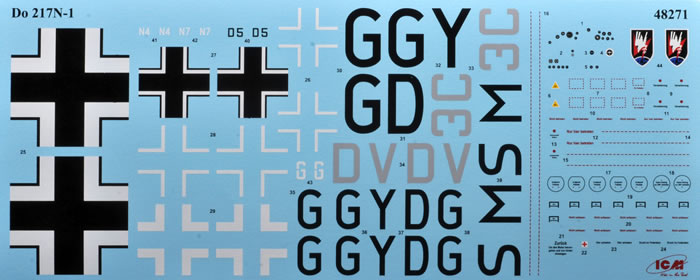
Markings are offered for four options:
-
Dornier Do 217 N-1. Prototype No. 4, GG + YD (radio codes), Rechin, Germany, Spring 1943. Finished in RLM 76 Light Blue lower surfaces and RLM 75 Grey Violet upper surfaces with low fuselage demarcation.
-
Dornier Do 217 N-1. Prototype No. 7, GG + YG (radio codes) Rechin, Germany, Summer 1943. Finished in RLM 76 Light Blue lower surfaces and RLM 75 Grey Violet on the upper surfaces with high fuselage demarcation. The kit instructions suggest a splinter pattern of RLM 75 Grey Violet and RLM 74 Grey Green, but wartime photos look more like a single RLM 75 to me.
-
Dornier Do 217 N-1. D5 + SM, Denmark, December 1944. Finished in RLM 76 Light Blue lower surfaces with a splinter pattern of RLM 75 Grey Violet and RLM 74 Grey Green featuring high fuselage demarcation.
-
Dornier Do 217 N-1. 3C + DV, Germany, late 1943. Finished in overall black.
Stencil markings are included on the main decal sheet.
It is great to see ICM working their way through important and interesting variants in their 1/48 scale Dornier Do 17 and 217 families.
Surface textures, detail and moulding are all delivered to a very high standard, and the parts breakdown (in particular the ability to build the engine nacelles without the engines) should make this an easier build some of their earlier releases.
The model looks great in the box. Now the only remaining question is, how does it build?
Sample purchased by the reviewer from Hannants
Review Text and Images Copyright © 2019 by Brett Green
Page Created 4 July, 2019
Last updated
5 July, 2019
Back to HyperScale Main Page
Back to Reviews Page

|
Home
| What's New |
Features |
Gallery |
Reviews |
Reference |
Forum |
Search